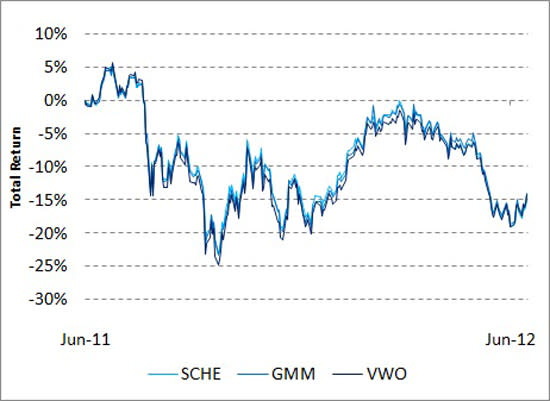Top Emerging Markets ETFs
Emerging markets have been seducing investors for the past decade -- high growth, big returns, and global economic domination are just some of the theme’s siren notes.
Retail investors were told they needed emerging markets exposure in their portfolios, and for a long time they mindlessly clicked “buy” on shares of big, broad, market cap weighted ETFs, such as the iShares MSCI Emerging Markets Index Fund (EEM - News).
Thanks in part to our own Matt Hougan, that status quo changed and investors began digging deeper and started buying its cheaper, more representative cousin, the Vanguard MSCI Emerging Markets ETF (VWO - News).
But did they dig deep enough?
It seems the answer to that question is very much a work in progress, as EEM and VWO still have a massive duopoly in the emerging market ETF space despite tracking the exact same index.
Fully 98 cents of every dollar in an emerging market total market equity fund is in VWO or EEM. Same goes for trading:the two funds get more than 98 percent of the daily volume of all funds in the segment.
But that doesn’t make them the best. Sure, they’re even easier to trade than many domestic ETFs, and the cost of trading them is minimal -- 3 basis points on average – which is a key consideration.
But are there better choices out there?
South Korea’s Status
One of the big dividing lines in the emerging markets space is what to do with South Korea.
MSCI considers the country to be an emerging market, while S'P and FTSE consider it to be developed (That may change on Wednesday, June 20, when MSCI unveils possible changes to its country classification list, with South Korea possibly in line to get promoted to developed market status.)
In any case, because VWO and EEM track an MSCI index, South Korea is included.
The $200 million SPDR S'P Emerging Markets ETF (GMM - News) tracks an S'P emerging markets index that doesn’t include South Korea. Neither does the Schwab Emerging Markets Equity ETF (SCHE - News), which tracks a FTSE emerging markets index weighted by market cap.
Instead of debating the relative merits of each argument determining whether South Korea is an emerging market or not, it’s really best to let the market tell us.
After all, it stands to reason that the millions of participants in global asset markets are better at determining the true classification of a country better than a small committee of Ivy League graduates.

As you can see by the chart above, the performance of VWO, SCHE, and GMM have been similar.
The inclusion or exclusion of South Korea has had little impact on the portfolios, which is a crude way of measuring whether it belongs in the emerging markets universe.
That said, GMM and SCHE are two very different portfolios and, as a result there are many different factors at play here. The two portfolios allocate the 15 percent weighting to South Korea in VWO’s portfolio in different ways.
GMM bumps the exposure to Taiwan, China, Brazil, and South Africa by anywhere from 1 to 3 percentage points, while SCHE bumps China’s exposure up 9 percentage points and South Africa’s by 10 percentage points.
To put those sans South Korea adjustments into perspective, VWO weights Taiwan at 11.4 percent; China at 17.9 percent; Brazil at 15.5 percent; and South Africa at 7.4 percent, according to Vanguard’s website.
Still, apart from South Korea, both SSgA’s GMM and Schwab’s SCHE are made up exclusively of countries even MSCI considers to be emerging markets. In other words, the comparison still holds.
By this admittedly crude measurement, it seems like the market has spoken, and the inclusion of South Korea in emerging portfolios remains the right call.
So if removing South Korea isn’t the answer, what is?
I’d like to take a look at two different strategies, both of which entail repurposing an MSCI emerging markets index.
The first is equal weighting the universe as the Guggenheim MSCI Emerging Markets Equal Weight ETF (EWEM - News) does. The other is removing the currency component of the portfolio’s return through hedging as the db-X MSCI Emerging Markets Currency-Hedged Equity ETF (DBEM - News) does.

Over the past year, the equal-weighting strategy has lagged VWO by more than 4 percentage points. Meanwhile the currency-hedged portfolio of DBEM outperformed both strategies.
This may come as little consolation as DBEM’s outperformance meant a 10 percent loss, but when faced with the choice of losing less or losing more, investors will always choose the former.
Last year removing the currency from the equation mitigated losses.
But making a single foreign-currency call, let alone making a multiple-currency call in the case of a multi-country emerging markets ETF, may be a bridge too far for most investors.
DBEM is a very straightforward way of altering the exposure offered by VWO and EEM, but some investors may be choosing the theme with the goal of getting exposure to the local currencies with the hope they will rise against the dollar along with the fortunes of their citizens.
That makes VWO and EEM the right choice for investors unwilling to try one of the many nuanced strategies floating around the industry --whether they be low volatility, alpha seeking, or high beta.
After all, those funds may end up being the right choice moving forward, but since so many of them are new, it’s hard to compare their historic performance against more established funds.
For investors that means market-cap weighted funds or bust -- and add a side of South Korea.
I know my colleagues Dennis and Ana have recently blogged thoughtfully about moving beyond VWO and EEM, but what I’m saying is don’t go fixing something that ain’t broke.
Permalink | ' Copyright 2012 IndexUniverse LLC. All rights reserved
